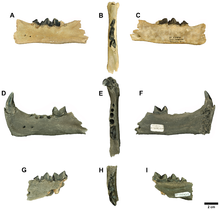Rhizosmilodon
- Machine translation, like DeepL or Google Translate, is a useful starting point for translations, but translators must revise errors as necessary and confirm that the translation is accurate, rather than simply copy-pasting machine-translated text into the English Wikipedia.
- Consider adding a topic to this template: there are already 1,926 articles in the main category, and specifying
|topic=will aid in categorization. - Do not translate text that appears unreliable or low-quality. If possible, verify the text with references provided in the foreign-language article.
- You must provide copyright attribution in the edit summary accompanying your translation by providing an interlanguage link to the source of your translation. A model attribution edit summary is
Content in this edit is translated from the existing German Wikipedia article at [[:de:Rhizosmilodon]]; see its history for attribution. - You may also add the template
{{Translated|de|Rhizosmilodon}}to the talk page. - For more guidance, see Wikipedia:Translation.
| Rhizosmilodon Temporal range: Early Pliocene PreꞒ Ꞓ O S D C P T J K Pg N ↓ | |
|---|---|
 | |
| Fossil specimens | |
| Scientific classification | |
| Domain: | Eukaryota |
| Kingdom: | Animalia |
| Phylum: | Chordata |
| Class: | Mammalia |
| Order: | Carnivora |
| Suborder: | Feliformia |
| Family: | Felidae |
| Subfamily: | †Machairodontinae |
| Tribe: | †Smilodontini |
| Genus: | †Rhizosmilodon Wallace & Hulbert, 2013 |
| Type species | |
| Rhizosmilodon fiteae Wallace & Hulbert, 2013 | |
Rhizosmilodon is an extinct genus of saber-tooth cat of the subfamily Machairodontinae that lived during the Early Pliocene and was discovered in the U.S. state of Florida.[1] Comparable in size to a medium-sized modern jaguar at about 165 lb. in weight, fossils of Rhizosmilodon are known only from Florida. The best specimens for this species are its lower jaw and teeth, which carry intermediate characteristics between advanced forms such as Smilodon and primitive forms such as Paramachairodus. It was likely an ambush predator, preying on animals such as deer, tapirs and horses.[2]
Phylogeny
Phylogenetic relationships of Rhizosmilodon with other Machairodonts based on analysis of 37 cranio-mandibular characters.[1]
| |||||||||||||||||||||||||||||||||||||||||||||||||||||||||||||||||||||||||
References
- ^ a b Wallace, S. C.; Hulbert, R. C. (2013). Larson, Greger (ed.). "A New Machairodont from the Palmetto Fauna (Early Pliocene) of Florida, with Comments on the Origin of the Smilodontini (Mammalia, Carnivora, Felidae)". PLOS ONE. 8 (3): e56173. doi:10.1371/journal.pone.0056173. PMC 3596359. PMID 23516394.
- ^ "Rhizosmilodon fiteae". 31 March 2017.
- v
- t
- e

- Megantereon
- Paramachaerodus
- Promegantereon
- Rhizosmilodon
- Smilodon
 | This article related to prehistoric animals from order Carnivora is a stub. You can help Wikipedia by expanding it. |
- v
- t
- e
 | This felid-related article is a stub. You can help Wikipedia by expanding it. |
- v
- t
- e











